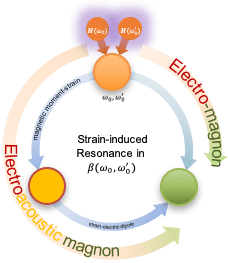Static and Dynamical Properties of Multiferroics
Student: Sayed Omid Sayedaghae
Degree: Ph.D., August 2020
Major Professor: Dr. Laurent Bellaiche
Research Area(s):
Modeling & Simulation
Nanoscience & Engineering
Background/Relevance
-
The cross coupling between magnetism and ferroelectricity in magnetoelectric (ME) materials allows magnetic-field (electric-field) control of polarization (magnetization). Controlling one ferroic order by varying the other one is promising in the data storage media. The coupling between magnetic field and polarization can take place directly or mediated indirectly by strain
Innovation
-
A new quasiparticle, coined electroacoustic magnon, can enhance the ME response of multiferroics.
Approach
-
The dynamical cross-coupling between magnetic field and polarization as well as the quadratic magnetoelectric response of BiFeO3 (BFO) was studied by means of Molecular Dynamics (MD) simulations within the framework of an effective Hamiltonian scheme under the conditions of clamped and unclamped homogeneous strain. The magnetic field was a combination of a dc field and an ac field with various frequencies. More investigations were conducted by developing an analytical model based on Landau theory to derive two components of the quadratic ME response of BFO, β(0,ω) and β(ω,ω).
Key Results
-
Fourier analyses of temporal evolution of polarization, magnetization, and homogeneous strain reveal the existence of a new quasiparticle (a mixture of optical phonon, acoustic phonon, and magnon) which we coined electroacoustic magnon.
-
Predicted by our analytical model, and verified by MD calculations, when the homogeneous strain is unclamped, the magnetoelectric response of BiFeO3 experiences resonances when the frequency of applied magnetic field corresponds either to the frequency of electroacoustic magnons or to half of that frequency.

Conclusions
-
The strain-mediated coupling between electric and magnetic moments can be employed to achieve larger magnetoelectric responses by tailoring the size and shape of samples and adjusting the magnetoelectricity of materials through dynamical resonances.
-
The enhancement of magnetoelectric responses can pave the way towards the design of novel ME devices.
Future Work
-
In future, the same approaches and techniques will be employed to study (i) the dynamical magnetoelectric effect within the domain walls of BFO, and (ii) the magnetoelectric coefficient under the influence of applying electric field.
